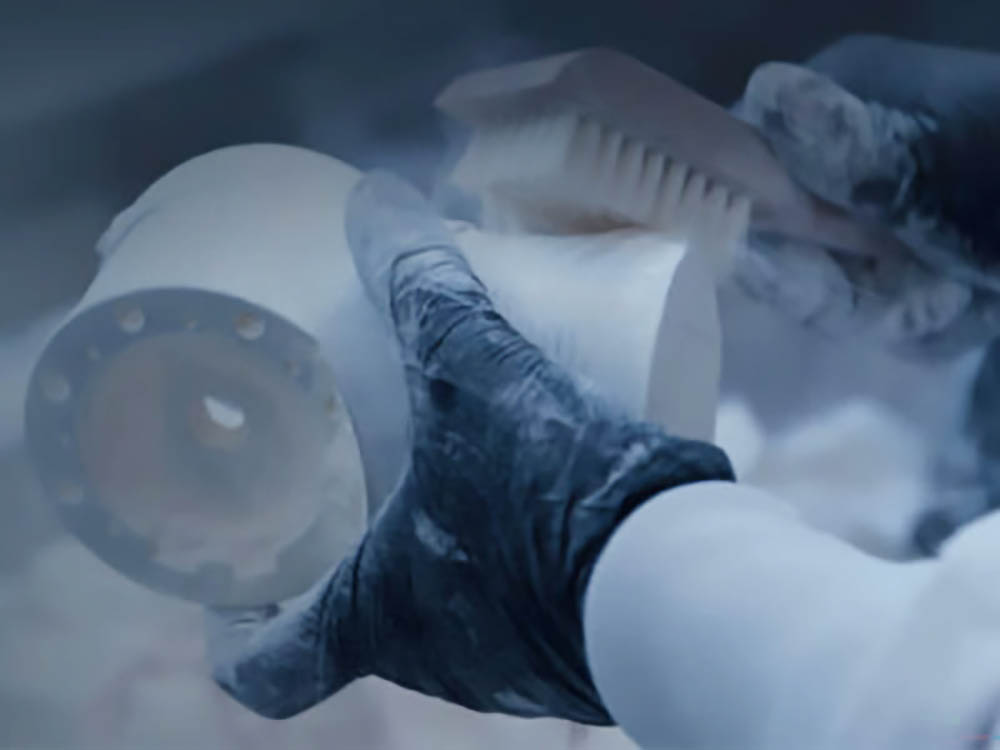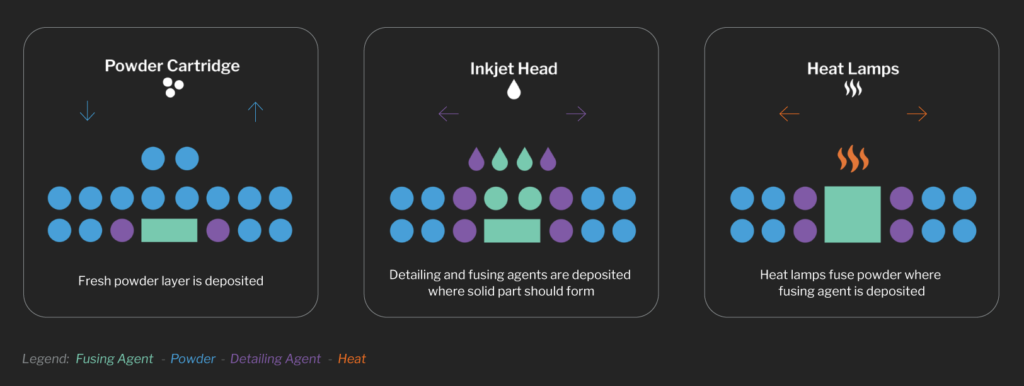

Originally published on fastradius.com on October 20, 2021
Multi Jet Fusion enables the efficient production of end-use nylon parts using additive technologies. Here’s a checklist for design teams.
Multi Jet Fusion (MJF) is an industrial form of 3D printing that can be used to produce functional nylon prototypes to higher volume production parts with exceptional design freedom and mechanical properties. The MJF process works by using inkjet nozzles to selectively distribute fusing and detailing agents across a bed layered with nylon powder. Unlike selective laser sintering, which uses lasers to fuse the powder into solid material, the MJF printer uses a continuous sweeping motion to distribute agents and apply heat across the print bed layer by layer until the part is finished, MJF can produce high-quality parts at high speeds.


This manufacturing process also does not require support structures to produce parts, making it possible to create complex geometries like internal channels or co-printed assemblies. MJF parts have mechanical properties comparable to injection-molded ones, but without the need for expensive tooling.
Designing for manufacturability will go a long way in ensuring optimal part quality and yield, minimizing post-processing needs, and driving cost reductions. Here’s a quick checklist to help your team ensure that you’re following MJF design best practices.
Before diving into design changes, it is important to ensure that the MJF process will meet all product requirements. Here are a few questions to ask yourself:
While MJF has many strengths, it has a limited list of approved materials. PA12 and its glass bead counterpart are fairly versatile for rigid plastic applications. TPU, a flexible polyamide, can find use where an elastomeric material is required. If the available materials do not meet a specific requirement, you may need to consider a different process.
One key limiting factor is the machine’s build volume, which is 380 x 380 x 284mm for the Jet Fusion 4200. In some cases, large parts can be printed as smaller subcomponents and assembled using adhesive or mechanical joints. In this case, design features such as dovetail joints may facilitate alignment and adhesion.
While the gap between additive and injection molding tolerances is narrowing, it is important to make sure that MJF’s tolerances are sufficient within the context of your assembly.
In most cases, MJF defects are caused by thermal gradients that develop during the build. If the material cools unevenly, the piece may warp or develop sinks. Parts that are long and thin, have abrupt changes in cross-sections, or have thin curved surfaces are especially prone to shrink-induced warp.
Removing material from part designs wherever possible through the use of pockets, shelling, lattices, and topology optimization is key to mitigating and preventing these defects. Avoiding large changes in cross-sections is another way to limit warp. Ensure that chamfers and fillets are incorporated where needed throughout the part design to make the transitions between different features more gradual.
In general, the wall thickness of MJF-printed parts should be a minimum of 1.5mm. Small design features should also be no smaller than 1.5mm, though some features such as slits, embossing, engraving, or the diameters of holes and shafts can be as small as 0.5mm. For embossed or debossed text, the font should be no smaller than 6pt (approximately 2mm) and should be a minimum of 0.3mm deep.
If a part includes screw threads, they should be M6 or larger. Where smaller, more precise, or more durable threads are needed, consider using threaded inserts. Beyond feature resolution, you should also consider how small, slender features might break off in post-processing.
Even with the greater geometric flexibility provided by the MJF process, some applications may still require a part to be assembled from multiple components. In general, mating faces should have 0.4 – 0.6mm of clearance to ensure that the components can properly fit.
If your project involves co-printing assemblies, the components printed together should have at least 0.5mm of clearance, but may require more, particularly when there are thick cross sections or there is a significant contact surface area.
If your part requires post-processing, there are a few things to double-check in your design to help make secondary operations more effective.
Besides improving part quality, intelligent DFM changes can drive cost savings. Lightweighting your part, for example, reduces the risk of defects and lowers the material cost per part. The other main consideration when designing for MJF and cost is optimizing nestability in a build. Adding draft or altering the position of printed assemblies may increase the number of parts that can fit per build and distribute fixed costs over more parts, lowering the overall part cost.
In addition to optimizing designs for manufacturability, additional factors to consider include your part’s cosmetics, surface finish, and ease of storage and transportation. MJF parts are naturally grey, but can be dyed black easily. If painting, priming, or other processes are not essential to the part’s function, they can be foregone to reduce expenses. Most MJF-printed parts will have a 125-250 microinches RA finish — if a smoother surface is needed, the part can undergo a variety of surface treatments, including sanding, tumbling, or vapor smoothing. Texturing can be an effective design technique to improve part aesthetics without additional post-processing.
Adhering to DFM principles is key to the success of manufacturing processes for a number of reasons. It helps to keep your operating expenses as low as possible, allows you to detect and address design issues early, and improves your overall part quality. This checklist is a valuable resource for making sure your MJF parts are optimized and refined before production begins.
The added advantage of partnering with SyBridge is that your team gains access to the latest in digital design technologies and expert advice. Our team is standing by to help guide each project from design and prototyping through to fulfillment, ensuring that you receive superior-quality parts on time and at the right price. Contact us today to get started.
Forget typical cycle times. We're pushing the boundaries of conformal cooling. While traditional approaches deliver…
Forget typical cycle times. We're pushing the boundaries of conformal cooling. While traditional approaches deliver…
From left to right: Brayden Janak (apprentice); Logan Vifaquain (CNC machining, Programming and CMM); Ron…
SyBridge Technologies is proud to announce we have been awarded the 2023 General Motors Supplier…
Today, designers and engineers are accustomed to working with digital tools in their day-to-day jobs.…
Optimizing Your Injection Molding Process for Cost-Effective Manufacturing Excellence In today’s competitive landscape, manufacturers are…